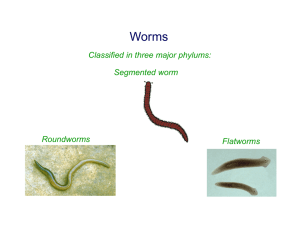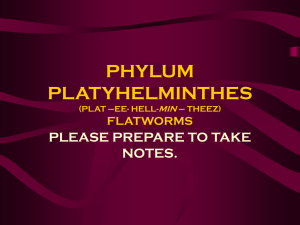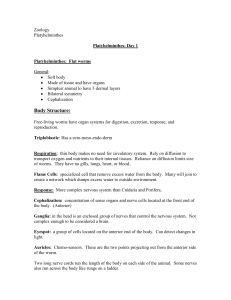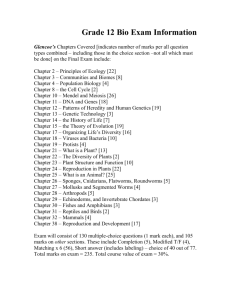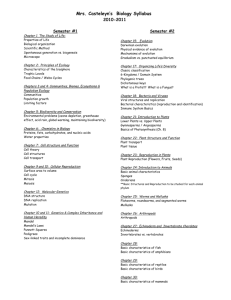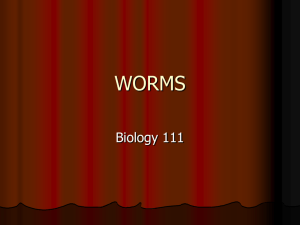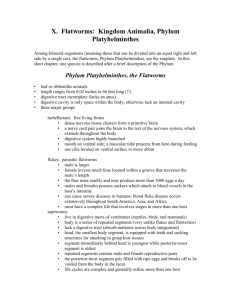kinds of worms - Local.brookings.k12.sd.us
advertisement
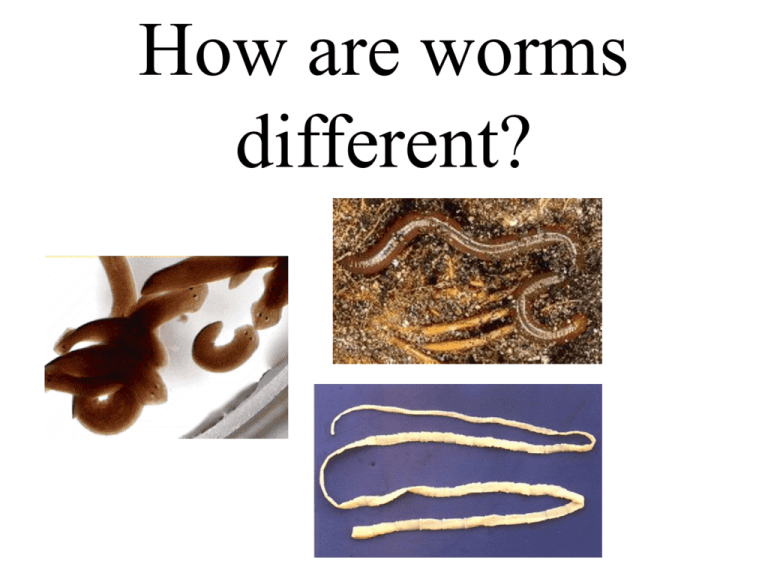
How are worms different? ALL WORMS are: INVERTEBRATES (no backbone) PROTOSTOMES (blastopore mouth) COELOM TYPES: Flatworms = acoelomates Round worms = Pseudocoelomates Segmented worms = coelomates FLAT WORMS (PLATYHELMINTHES) TAPEWORMS PLANARIA FLUKES FLATWORMS (PLATYHELMINTHES) Planaria (Cross-eyed worm) DIGESTIVE/CIRCULATORY SYSTEMS One big cavity for digestion and circulation = Gastrovascular cavity Only one opening- in and out through mouth MOUTH in middle on VENTRAL SURFACE NERVOUS SYSTEM SHOW SIMPLE LEARNING CEPHALIZATIONCEREBRAL GANGLIA with 2 VENTRAL NERVE CORDS PLANARIA RESPIRATORY Exchange gases through skin REGENERATION (Ability to regrow lost body parts) REPRODUCTION HERMAPHRODITES- SEXUAL trade sperm with other worms lay eggs in protective sac on rocks Can also use REGENERATION for ASEXUAL reproduction FLATWORMS PLANARIA • Free living • Digestive cavity with one opening/mouth in middle of body • Open circulatory system (shared Gastrovascular cavity) • Flame cells for excreting nitrogen waste and excess water • Cephalization-Cerebral ganglia with 2 nerve cords • Hermaphrodites with sexual reproduction (asexual reproduction using regeneration) • Eye spots sense light and dark • NO tegument or cuticle FLATWORMS (Nematoda) FLUKES Leaf shaped body Covered by TEGUMENT for protection for host immune system DIGESTIVE/CIRCULATORY shared GASTROVASCULAR cavity similar to Planaria MOUTH at anterior end NOT middle of body SUCKERS (anterior and ventral) help it hold on and suck blood NERVOUS CEPHALIZATION Cerebral ganglia with 2 nerve cords No eyes EXCRETORY Flame cells remove nitrogen waste & regulate water FLUKES REPRODUCTIVE Most hermaphrodites Some have separate sexes (Blood fluke-Schistosoma) Complicated life cycle with 2 hosts EX: Blood fluke-Schistosoma Adults live in human- sexual reproductio Larva live in snails – asexual reproduction HOW DO THEY INFECT HUMANS? Eggs pass out in feces Primary host: Human Larva burrow into skin Intermediate host: snail FLATWORMS • • • • • • • • • • FLUKES Flattened leaf shape Digestive cavity with one opening /mouth at anterior end Open circulatory system (Gastrovascular cavity) Flame cells for excreting nitrogen waste and excess water Cephalization -Cerebral ganglia with 2 nerve cords Hermaphrodites with sexual reproduction NO Eyes Parasitic with 2 suckers (anterior & ventral) for attaching to host Requires 2 hosts to complete life cycle TEGUMENT for protection from host immune system FLATWORMS (Platyhelminthes) TAPEWORMS SCOLEX with hooks and suckers at anterior end to help worm attach and hold on NO DIGESTIVE SYSTEM No mouth/ Absorbs nutrients through its tegument EXCRETORY Flame cells NERVOUS Cephalization Cerebral ganglia with 2 nerve cords NO eyes TEGUMENT protects from host digestive enzymes and immune system TAPEWORMS REPRODUCTIVE • Hermaphroditescan fertilize self or trade sperm with other worms • Grow by adding PROGLOTTIDS which contain both male and female reproductive organs 30 foot worm can have 2000 proglottids REPRODUCTION COMPLICATED LIFE CYCLES need 2 hosts to complete life cycle EX: BEEF TAPEWORM Adults feed and reproduce in humans larva make cysts in cow HOW DO THEY INFECT HUMANS? Primary host: Human Intermediate host: cow FLATWORMS TAPEWORMS • NO digestive system/nutrients absorbed through tegument • Flame cells for excreting nitrogen waste and excess water • Cerebral ganglia with 2 nerve cords • Parasitic with hooks & suckers (scolex) for attachment in host • Tegument for protection from host immune system and digestive juices • Hermaphrodites with sexual reproduction Use PROGLOTTIDS to reproduce • No Eyes

